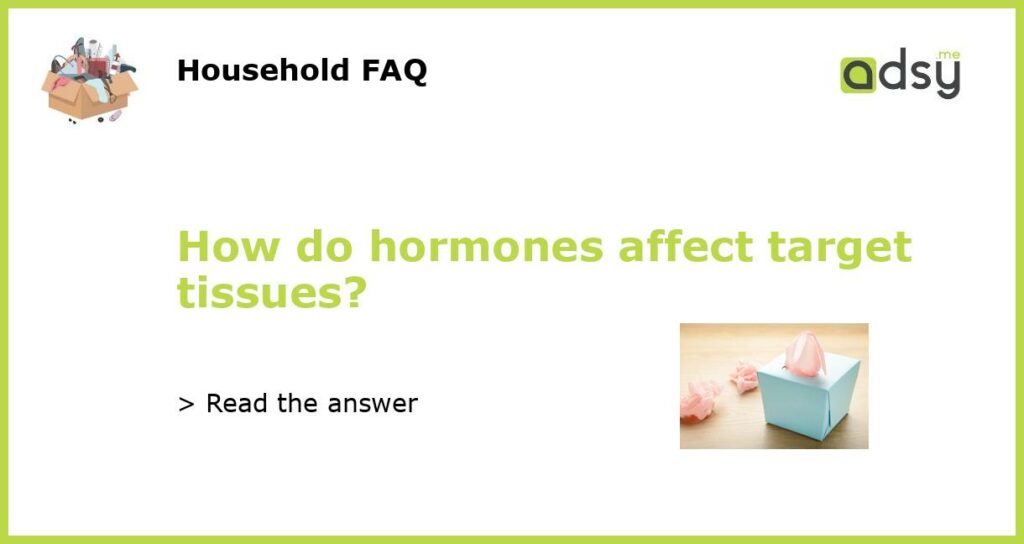Hormones: Messengers of the Body
Hormones are chemical messengers that are produced by various glands in the body. They are secreted into the bloodstream and travel to different target tissues or organs where they exert their effects. These target tissues have specific receptors that recognize and bind to the hormones, initiating a cascade of biochemical reactions that ultimately lead to various physiological responses. In this article, we will explore how hormones affect target tissues and the mechanisms behind their actions.
Understanding Hormone-Receptor Interaction
Hormones act on target tissues by binding to specific receptors on the surface of or within the cells of these tissues. These receptors are highly specific for a particular hormone and, once bound, undergo conformational changes that initiate a signaling cascade. The binding of the hormone to its receptor triggers a series of biochemical events that ultimately result in a cellular response. This response can include changes in gene expression, enzyme activation or inhibition, alteration of ion channel activity, or modulation of cell growth and differentiation.
The Role of Second Messengers in Hormone Signaling
Many hormones do not directly act on their target tissues but instead utilize second messengers to relay their signals. A second messenger is a molecule that is generated within the target cell in response to hormone-receptor binding. One of the most well-known second messenger systems is the cyclic adenosine monophosphate (cAMP) pathway. When a hormone binds to its receptor on the cell surface, it activates an enzyme called adenylate cyclase, which generates cAMP from adenosine triphosphate (ATP). cAMP then activates protein kinase A (PKA), which in turn phosphorylates various target proteins, leading to a cellular response.
Examples of Hormone Actions on Target Tissues
Hormonal signaling is involved in numerous physiological processes, and different hormones can exert diverse effects on target tissues. For example, insulin is a hormone produced by the pancreas that regulates blood glucose levels. When insulin binds to its receptor on the surface of liver, muscle, and fat cells, it stimulates the uptake of glucose from the bloodstream, allowing these tissues to utilize it for energy production or storage. In contrast, glucagon, another hormone produced by the pancreas, increases blood glucose levels by promoting the breakdown of glycogen in the liver.
Another example is the hormone adrenaline or epinephrine, which is released by the adrenal glands in response to stress or danger. Adrenaline acts on target tissues such as the heart, blood vessels, and lungs to increase heart rate, constrict blood vessels, and dilate the airways, preparing the body for the fight or flight response. These are just a few examples of how hormones can elicit specific responses in their target tissues.
Regulation of Hormone Action
The actions of hormones on target tissues are tightly regulated to maintain homeostasis in the body. This regulation can occur at different levels, including hormone synthesis and release, hormone-receptor interaction, and hormone degradation. Hormone synthesis and release are influenced by various factors such as nutritional status, environmental cues, and feedback loops involving other hormones.
Additionally, the number and sensitivity of hormone receptors on target tissues can be regulated. For example, prolonged exposure to high levels of a hormone can lead to a downregulation of its receptors, reducing the tissue’s responsiveness to the hormone. On the other hand, low levels of a hormone can result in upregulation of its receptors, increasing the tissue’s sensitivity. These mechanisms help ensure that the target tissues only respond appropriately to the hormonal signals they receive.
Hormones play a crucial role in regulating various physiological processes in the body. They act on target tissues by binding to specific receptors and triggering a cascade of biochemical events that lead to specific cellular responses. Hormonal signaling can involve the use of second messengers to relay signals and can elicit diverse effects on target tissues. The actions of hormones on target tissues are tightly regulated to maintain homeostasis, and imbalances in hormone levels or receptor sensitivity can lead to various endocrine disorders. By understanding how hormones affect target tissues, scientists and healthcare professionals can develop strategies to modulate hormonal signaling for therapeutic purposes.






